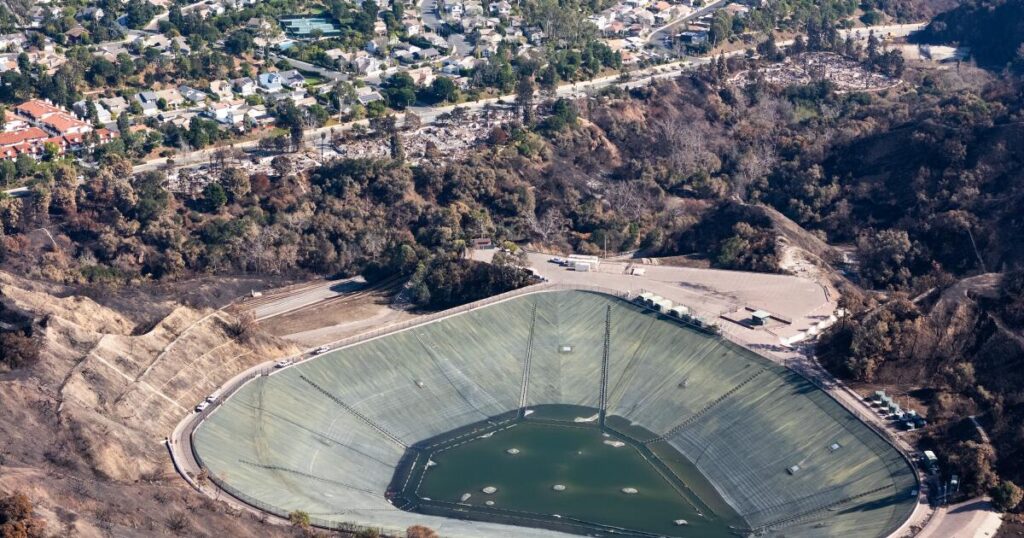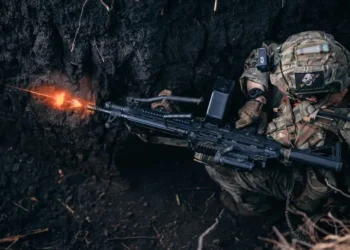In January, when crews fighting the fast-spreading Palisades fire were hampered by low water pressure and dry hydrants, Gov. Gavin Newsom ordered an investigation.
After a 10-month review, California officials concluded in a report that the water supply in Southern California was “robust” at the time of the fire and that the water system isn’t designed to handle such large, intense wildfires.
The state’s findings, released Thursday, also address an issue that has been a point of frustration and anger among residents in Pacific Palisades: the fact that Santa Ynez Reservoir, which can hold 117 million gallons of drinking water, was empty for repairs at the time of the fire.
“Draining the Santa Ynez reservoir was necessary to protect public health while repairing the tear in its cover and required by both federal and state regulations,” the report says. Even if the reservoir had been full, the flow rate in the system’s pipes “would have been a limiting factor in maintaining pressure and the system would have been quickly overwhelmed” and hydrants would have lost pressure.
The state’s findings are in line with what L.A. water officials have said about the reservoir, the water system and the factors that caused the loss of water pressure.
“The report confirms that the Santa Ynez Reservoir was offline to make necessary repairs and that issues with water pressure during the fire response were due to the extraordinary demand on the system, not because of inadequate water supply,” said Ellen Cheng, a spokesperson for the Los Angeles Department of Water and Power.
The deadly firestorms in Pacific Palisades and Altadena revealed the limitations of California’s urban water systems, which experts say are not designed with the capacity for large wildfires that rage through entire neighborhoods.
State officials said in the report that without further data and analysis, it is not clear exactly how much longer a full reservoir might have kept hydrants running, but that “based on experiences with prior fires,” the demands on the system were so large that they would have quickly exceeded the system’s maximum.
The L.A. Department of Water and Power said in a July report that the Palisades fire’s swift spread “led to extraordinary demands” on a part of the system called the Westgate Trunk Line, as firefighters drew from hydrants and residents left sprinklers and hoses running. In addition, as homes burned, water gushed from their damaged pipes, contributing to the loss of pressure.
When the system lost pressure in parts of Pacific Palisades, some fire hydrants in high-elevation areas ran dry.
Similar loss of pressure has occurred during other big California wildfires, including the Tubbs and Thomas fires in 2017 and the Camp and Woolsey fires in 2018.
DWP officials have said they took steps to make water available for firefighters, including by deploying water tankers and trucks to Pacific Palisades. However, the Los Angeles Fire Department said in a report last month that firefighters faced delays in getting vital water trucks into the area.
During the fire, water-dropping helicopters were able to refill at DWP’s three open-air reservoirs, which, unlike the Santa Ynez Reservoir, are not part of the drinking water system and are available for firefighting. The state’s report notes that aircraft were temporarily grounded because of high winds on Jan. 7 and 8 as the fire rapidly spread.
The Palisades fire killed 12 people and destroyed thousands of homes.
The state report was prepared for the governor’s office by agencies including the California Environmental Protection Agency, California Natural Resources Agency, California Office of Emergency Services, State Water Resources Control Board, Department of Forestry and Fire Protection, and Department of Water Resources.
“Community water systems facing a large-scale fire are bound by their physical limitations,” with the flow rate constrained by the capacity of pumps and the piping network, the report says. “Local water systems and hydrants are not designed to suppress firestorm conditions impacting an entire neighborhood of homes at the same time.”
The Palisades and Eaton fires exploded during high winds. After two wet winters that had fed the growth of vegetation on hillsides, Southern California had seen no significant rain in eight months. Scientists have estimated that human-caused global warming probably contributed roughly one-fourth of the dryness, one of the factors that fueled the fires’ rapid spread.
State officials noted that large Southern California reservoirs had ample water at the time of the fires, and that the local system in Pacific Palisades lost pressure “not due to a lack of water supply in the system, but because of an insufficient flow rate.”
“Even though there was plenty of water available in the system, it was not possible to pump enough water to the fire area all at once to meet the flow rate demand created by the leaking water from already destroyed structures and high water use from hydrants,” the report says.
A 20-member independent commission, the Blue Ribbon Commission on Climate Action and Fire-Safe Recovery, said in a June report that “protecting water supply and pressure for firefighting will require a coordinated regional approach, collaboration across agencies, and flexible access to alternative sources.”
Mark Gold, a member of the commission, said given the extreme dryness and fire risks, it was “not a good time to be doing large-scale maintenance projects that are going to keep any part of your water system offline.”
“We’ve got to be way smarter in taking into account the local conditions when we have any part of our water infrastructure offline,” he said.
To prepare for major fires intensified by extreme weather, the state report says, it’s essential to focus on having crews and equipment, including water tanker trucks, in place ahead of time to ensure there is water if hydrants run out.
DWP faces lawsuits filed by homeowners, who argue the utility failed to prepare for and adequately respond to the fire. The agency has said its crews and water system were prepared for emergency situations, but that “no urban water system is designed to combat a massive, wind-driven wildfire of the speed and scale” of the Palisades fire.
State officials said that with the risks of such extreme events increasing with climate change, efforts to fully implement a list of fire safety measures outlined in the state wildfire plan are crucial.
“California faces a fire year rather than a fire season,” the state report says. “And catastrophic wildfires affecting communities in the wildland urban interface can be driven and exacerbated by extreme weather events.”
The post Even a full reservoir wouldn’t have ensured water in Palisades fire, California officials say appeared first on Los Angeles Times.




